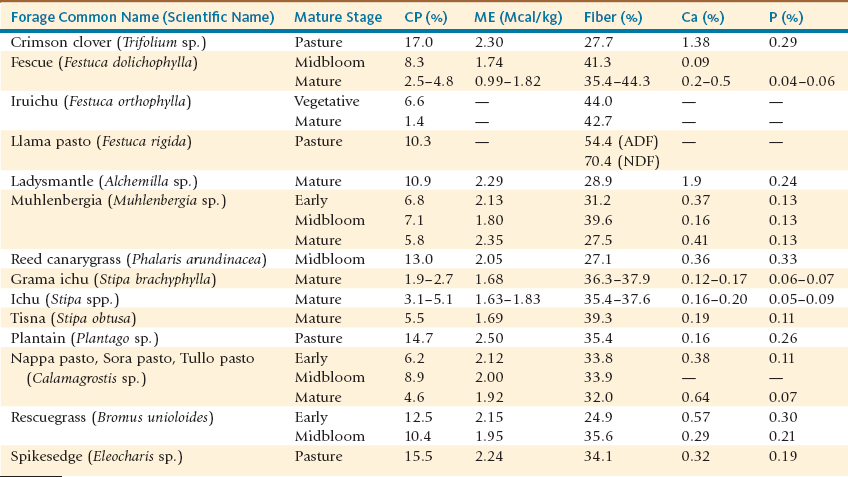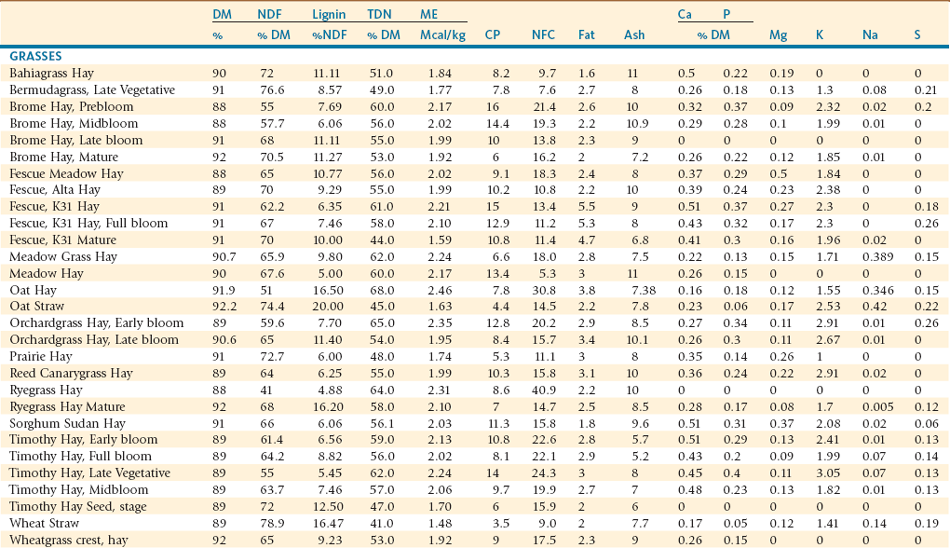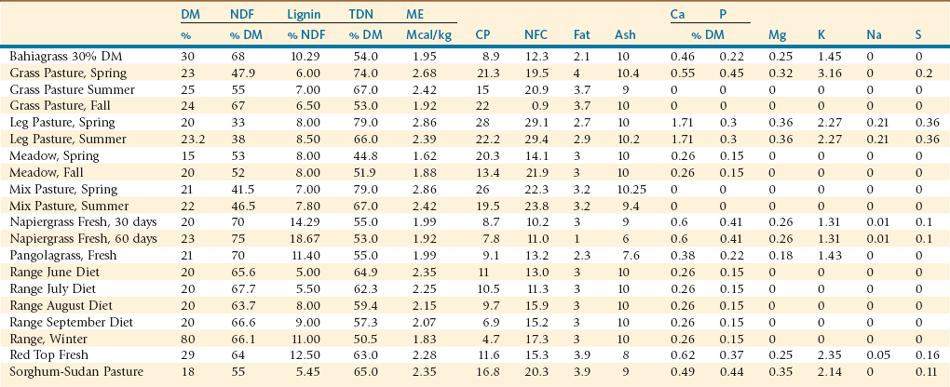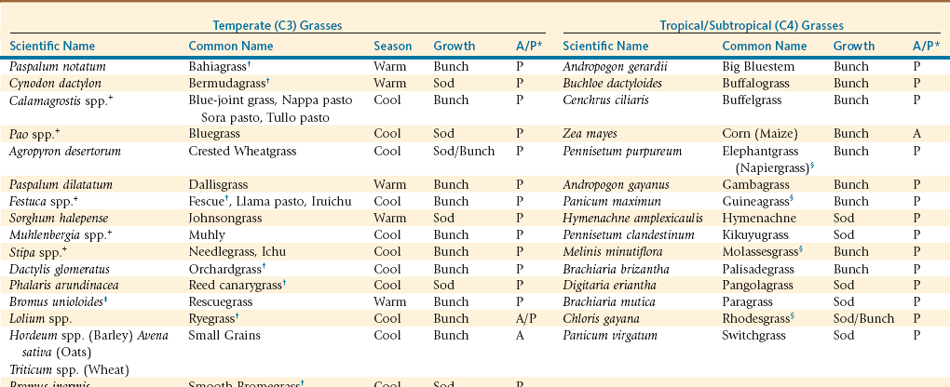Feeds for Camelids
Previous chapters in this section addressed aspects of applied gastrointestinal anatomy (Chapter 8) and nutritional requirements (Chapter 9) for South American camelids (SACs). Llamas and alpacas are well adapted to consume high-forage diets of variable quality. Feed costs account for the greatest portion of total production costs in any animal agricultural production system. In any feeding system, an appropriate balance must be struck between feed costs and providing adequate nutrients to meet defined requirements for desired production level. An appreciation of nutrient delivery limitations from forage, based on species and maturity stage, is essential to balancing an appropriate feeding program. Feeding management is the integration process of providing an adequately formulated diet to animals in a manner resulting in sufficient consumption to meet daily nutrient needs. Feed availability, environment, housing and feeding facilities, animal grouping strategies, and all interactions must be considered in defining necessary feeding management practices. This chapter will focus on forage types and their compositions and discuss supplement types and their application as they apply to feeding SACs.
Forages and Browse
Forages are bulky, high-fiber, and generally low-energy feeds derived from plants either in part or as a whole. Forages may be harvested directly by the animal, as in pasture, or mechanically harvested, partially dried (40% to 60% moisture) and ensiled or extensively dried (<15% moisture) as hay. In the native habitat of SACs, forages comprise 100% of the diet, even when managed domestically. A wide range of forages are selectively consumed by llamas and alpacas, depending on season.1–5 In contrast, SAC feeding management outside of South America often includes supplement feeding to complement the forage program. Most forage plants used for animal feed are separated into two large botanical families: (1) grasses (family Gramineae or Poaceae) and (2) legumes (family Leguminosae). An in-depth discussion of specific forages and associated agronomic practices is beyond the scope of this chapter, but comprehensive texts are available.6–9 Observed or averaged nutrient content of common grass and legume forages fed to llamas and alpacas in South America (Table 10-1) or used for hay (Table 10-2) and pasture (Table 10-3) production in North America are provided for comparison of nutrient contents.
TABLE 10-1
Nutrient Composition of Various Forages Consumed by Llamas and Alpacas in South America*

*All values on a dry matter basis.
From Fowler ME: Feeding and nutrition. In Fowler ME, Medicine and Surgery of South American Camelids: Llama, Alpaca, Vicuna, Guanaco, ed 2, Ames, 1998, Iowa State University Press (pp 12-48); San Martin FA: Comparative forage selectivity and nutrition of South American camelids and sheep (doctoral thesis), Lubbock, TX, 1987, Texas Tech University; Genin D, et al: Diet selection and utilization by llama and sheep in a high altitude-arid rangeland of Bolivia, J Range Management 47(3):245-248, 1994; and McDowell LR, et al: Latin American tables of feed composition. Gainesville, FL, 1974, University of Florida (p 53).
TABLE 10-2
Nutrient Composition of Various Dried Forages (Grasses and Legumes) Available in North America*


*All nutrient values, excluding dry matter, are on a dry matter basis.
Modified from feed composition tables in National Research Council: Nutrient requirements of beef cattle, rev ed 7, Washington, DC, 1996, National Academy Press.
TABLE 10-3
Nutritional Composition of Pastures (Grass, Legume, Mixed) in North America*

*All nutrient values, excluding dry matter, are on a dry matter basis.
Modified from feed composition tables in National Research Council: Nutrient requirements of beef cattle, rev ed 7, Washington, DC, 1996, National Academy Press.
Grasses
Grasses are the third most abundant group of agriculturally important plants in the world with more than 10,000 species, including all cereal grain–producing plants such as corn, wheat, rice, rye, barley, oats, sorghum, and millet. Detailed information on grass plant anatomy and biology can be found in a number of excellent texts on forage.6–8 Grasses are distinguished by their narrow leaves with parallel veins, round hollow stem, and inconspicuous flowers (termed inflorescence). The leaf is attached to the stem by its base (sheath) wrapping around a thickened, solid portion of the stem (node). The leaf proper (blade) contains photosynthetic organelles and a fibrous midrib of structural carbohydrate and lignin to maintain some rigidity. Leaves are the most digestible portion of a grass for animals. The supporting midrib causes a rapid decline in digestibility with advancing plant maturity because of the increasing presence of structural carbohydrate in the leaf.10 This decline in leaf digestibility is not seen in legume plants (see Legumes section). A majority of the grass plant mass occurs underground as a highly branched root system. This minimizes water loss through evaporation, allowing grasses to survive under arid conditions in which trees and other vegetation cannot.
Native and cultivated grasses account for the majority (>60%) of all domesticated livestock feed, especially for beef cattle, sheep, and camelids outside of South America. Most wild herbivores and SACs in South America subsist on grassland vegetation. Grasses tolerate predation (animal grazing) and compete better through their reproductive mechanisms. Unlike most other plants that grow from the tip of a leaf or shoot, grasses grow from the leaf base. This allows leaf regrowth following grazing, clipping, or burning. Certain grasses generate new growth (tillers) from their base (crown), resulting in a clump of growth (bunch grasses; Table 10-4).6–8 Other grasses send out horizontal stems either above (stolons) or below (rhizomes) ground to generate new shoots and roots.6–8 When the distance between new shoots is small, the grass forms a dense mat (sod) preventing other plants from encroaching.
TABLE 10-4
Some Common Temperate and Tropical Grass Species Typical of North and South Americas

*Annual (A) or Perennial (P) grass.
†Primary seeded forages used in United States; all are introduced species.
‡Plant species belonging to these grass genera are commonly found in South America and consumed by llamas and alpacas.
§Warm season tropical grasses that are cold tolerant.
From Barnes RF, et al: Forages, Volume 1: An introduction to grassland agriculture, ed 5, Ames, 1995, Iowa State University Press; and Mislevy P: Forages for grazing systems in warm climates. In McDowell LR, editor: Nutrition of grazing ruminants in warm climates, Orlando, FL, 1985, Academic Press (pp 73-103).
Photosynthesis is the process by which plants use radiant energy to combine atmospheric carbon dioxide with other nutrients from the soil (water, nitrogen, and minerals) to synthesize carbohydrates and proteins in support of plant growth and ultimately animal production. Thus, amount and intensity of solar radiation, soil nutrient content and characteristics, seasonal environmental temperature swings, and precipitation patterns influence a geographic region’s potential for grass growth and nutrient content. Grasses are one of the most highly adapted plants that have the ability to grow in geographic regions ranging from arctic to tropical conditions. Grass species are classified into two groups, temperate and tropical grasses, based on their initial compounds synthesized during photosynthesis (C3 versus C4) and optimal growth temperature (see Table 10-4). Temperate grasses generate 3-carbon compounds from photosynthesis and grow best in warm to cooler environments (32 to 68°F [0 to 20°C]). Tropical grasses produce 4-carbon compounds during photosynthesis and start to grow between 50°F and 59°F (10°C and 15°C) and reach maximal growth at 86°F to 95°F (30°C to 35°C). Although not universally true, tropical forages generate more structural carbohydrates (fiber) and have lower protein compared with temperate forages and hence are of lower digestibility. On average, tropical forages are 15 units lower in digestibility compared with temperate forages.10
Grasses have an annual or perennial growth pattern. Within the temperate grasses, adaptation to growing conditions varies. Some temperate grasses grow in cooler temperatures (cool season grasses), whereas others grow best in higher environmental temperatures (warm season grasses). Cool season grasses grow during spring and fall and are dormant during the hot summer months. Warm season grasses grow best during the hot summer months. Warm season grasses tend to be more drought resistant compared with cool season grasses. Pasture mixtures of cool and warm season grasses maintain forage mass and quality more uniformly through the growing season in temperate regions.
Legumes
In contrast to grasses, which are monocotyledon plants, legumes are dicotyledon plants. Cotyledons store reserve food for the new seedling to grow from the seed. Legume seeds are packaged within a unique fruit (pod) with a characteristic shape for differing species. Perennial, biennial, and annual growth patterns may be found among legume species. Approximately 12,000 species of legumes exist, with 4000 being grown in North America.6–8 Important agricultural temperate legume species include alfalfa (Medicago sativa), soybean (Glycine max), peanuts (Arachis sp.), clover (Trifolium sp.), sweetclover (Melilotus sp.), bird’s foot trefoil (Lotus sp.), lespedeza (Kummerowia sp. or Lespedeza sp.), lupines (Lupinus sp.), vetch (Vicia sp.) and various pea species.6–8 Clovers come in many species, including red, white, alsike, subterranean, arrowleaf, ball, berseem, and crimson. Tropical legumes are also plentiful and include jointvetch (Aeschynomene sp.), alyceclover (Alysicarpus sp.), rhizoma and pinto peanuts (Arachis sp.), Centrosema species, desmanthus (Desmanthus sp.), various Desmodium species, leucaena (Leucaena sp.), and many others.6,7 Alfalfa (lucerne) is the single most important agricultural forage grown. Over 55% of total hay grown in the United States is alfalfa or an alfalfa–grass mixture. Legumes have a more narrow geographic adaptation range compared with grasses and require more input to persist and maintain productivity.
Alfalfa and legumes in general are structurally very different from grasses, which results in important nutritive differences. Legumes have a tap root with lateral branches rather than the highly branched root system of grasses.6–8 Depending on the species, the legume tap root may reach deep (2–4 ft [0.6–1.2 m]) into the soil, providing the plant an opportunity to withstand drought conditions. Alfalfa is fairly heat tolerant and will maintain growth throughout the summer. Through a symbiotic relationship between Rhizobium bacteria and root hairs forming specialized root nodules, legumes take advantage of bacterially generated ammonia. Rhizobium bacteria using plant carbohydrates convert atmospheric nitrogen into ammonia, which then is used by the plant to make protein. As a result, legumes characteristically have higher plant protein content compared with grasses (see Table 10-2). The ability to fix atmospheric nitrogen also increases soil nitrogen resources for other plants, thus making seeding combinations of legumes and grasses beneficial to grass growth, which otherwise would require more nitrogen fertilization.
Forbs and Browse
All herbaceous (nonwoody) broadleaf vegetation not classified as grasses, grasslike plants, or legumes is collectively grouped as forbs. These plants are best recognized as ornamental plants and weeds. Browse includes all woody plants, primarily trees, bushes, and shrubs. When animals consume browse, they are usually eating selected structures such as buds, leaves, and twigs. Amount of forbs and browse consumed by an animal will depend on feeding behavior (see Diet Selectivity, Chapter 8) and prevailing vegetation availability. It must be remembered that many ornamental plants have the potential to be toxic, especially azaleas and rhododendrons. Forb plants in browsing areas must be accurately identified to ensure that they are not poisonous.
In most continents other than North America, forbs and browse are significant components of the feeding system for many animals, including llamas and alpacas. Given the abundance of high-quality cultivated forages in North America, the general consensus is that forbs and browse are of much lower nutritional quality and may even be deleterious. Perceptions about poisonous plants, noxious weeds, and tree bark all combine to reinforce the association of forbs and browse with low-quality feed. However, many animals around the world survive and flourish on these vegetative resources. Deer, moose, eland, giraffe, and goats all preferentially consume forbs and browse.10 Llamas and alpacas make use of forbs and browse during the dry season in South America and when opportunity arises in North America.1–4,11–13 Compared with cultivated forages, minimal data are available to confirm or refute the low-quality status of forbs and browse.
Llamas and alpacas have been observed to consume blackberry leaves, a common forb in North America, when it is present in a pasture. Seasonal compositional analysis of blackberry leaves shows them to be of high quality, approaching that of a legume plant.14 Besides its protein and energy density, blackberry leaves have significant amounts of a number of minerals that are often deficient in grass forages. Data summarizing many reports also suggest potentially high-quality vegetation from tree and shrub leaves.15 Digestible dry matter from tree and shrub leaves ranged from 17% to 67%, with most studies showing a range from 34% to 64%.15,16 The crude protein (CP) content of these leaves was also wide ranging, from 6.9% to 33%.15,16 Leaf material from a tree legume was found to have CP content between 22.5% and 29.4% and 19.4% and 28.8% for wet and dry season growth, respectively.16 It would seem that in situations where the prevailing forage is mature with high fiber and low protein, consumption of browse and forb material may be an appropriate resource for the animal to compensate for dietary deficiencies in forage.
Stay updated, free articles. Join our Telegram channel

Full access? Get Clinical Tree


